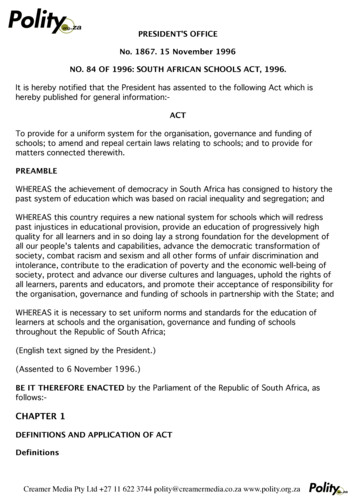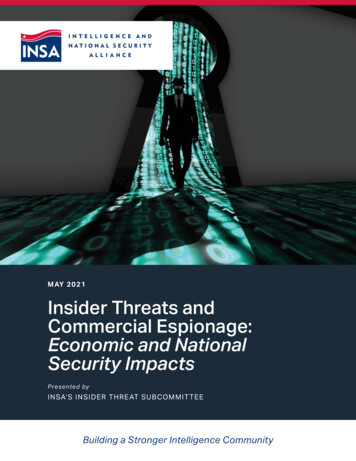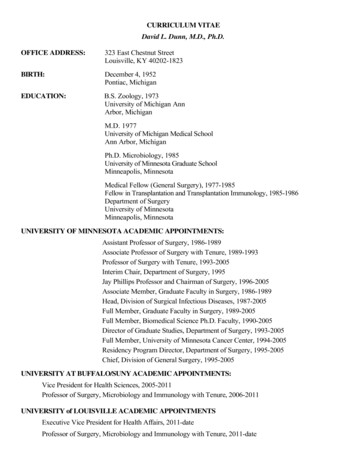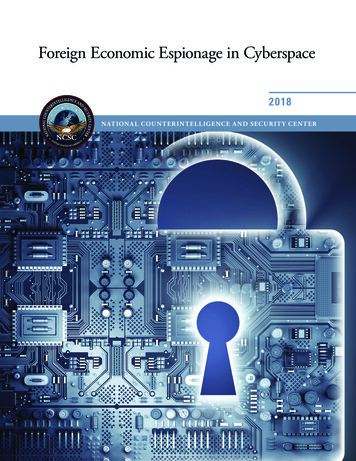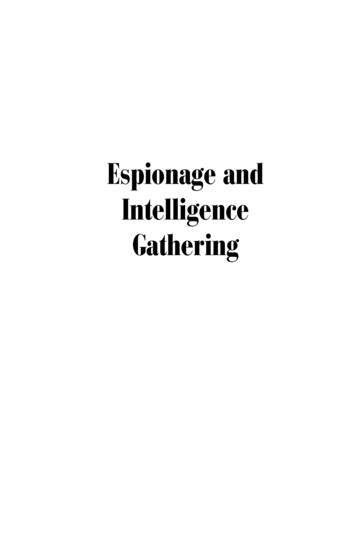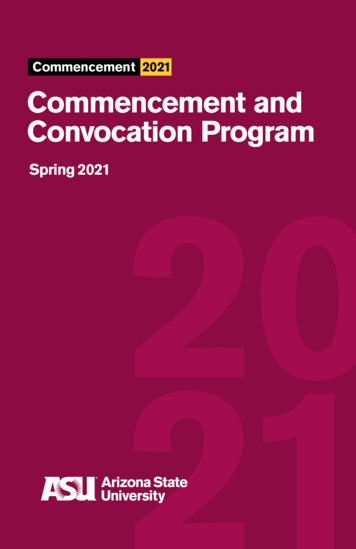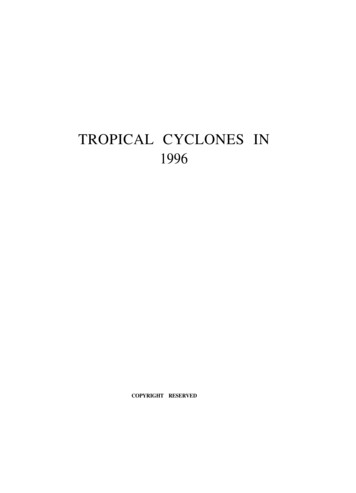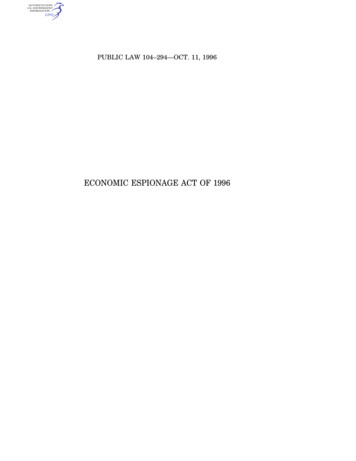
Transcription
PUBLIC LAW 104–294—OCT. 11, 1996ECONOMIC ESPIONAGE ACT OF 1996
110 STAT. 3488PUBLIC LAW 104–294—OCT. 11, 1996Public Law 104–294104th CongressAn ActOct. 11, 1996[H.R. 3723]EconomicEspionage Act of1996.18 USC 1 note.To amend title 18, United States Code, to protect proprietary economic information,and for other purposes.Be it enacted by the Senate and House of Representatives ofthe United States of America in Congress assembled,SECTION 1. SHORT TITLE.This Act may be cited as the ‘‘Economic Espionage Act of1996’’.TITLE I—PROTECTION OF TRADESECRETSSEC. 101. PROTECTION OF TRADE SECRETS.(a) IN GENERAL.—Title 18, United States Code, is amendedby inserting after chapter 89 the following:‘‘CHAPTER 90—PROTECTION OF TRADE 1838.‘‘1839.Economic espionage.Theft of trade secrets.Exceptions to prohibitions.Criminal forfeiture.Orders to preserve confidentiality.Civil proceedings to enjoin violations.Conduct outside the United States.Construction with other laws.Definitions.‘‘§ 1831. Economic espionage‘‘(a) IN GENERAL.—Whoever, intending or knowing that theoffense will benefit any foreign government, foreign instrumentality,or foreign agent, knowingly—‘‘(1) steals, or without authorization appropriates, takes,carries away, or conceals, or by fraud, artifice, or deceptionobtains a trade secret;‘‘(2) without authorization copies, duplicates, sketches,draws, photographs, downloads, uploads, alters, destroys, photocopies, replicates, transmits, delivers, sends, mails, communicates, or conveys a trade secret;‘‘(3) receives, buys, or possesses a trade secret, knowingthe same to have been stolen or appropriated, obtained, orconverted without authorization;‘‘(4) attempts to commit any offense described in any ofparagraphs (1) through (3); or
PUBLIC LAW 104–294—OCT. 11, 1996110 STAT. 3489‘‘(5) conspires with one or more other persons to commitany offense described in any of paragraphs (1) through (3),and one or more of such persons do any act to effect theobject of the conspiracy,shall, except as provided in subsection (b), be fined not more than 500,000 or imprisoned not more than 15 years, or both.‘‘(b) ORGANIZATIONS.—Any organization that commits anyoffense described in subsection (a) shall be fined not more than 10,000,000.‘‘§ 1832. Theft of trade secrets‘‘(a) Whoever, with intent to convert a trade secret, that isrelated to or included in a product that is produced for or placedin interstate or foreign commerce, to the economic benefit of anyoneother than the owner thereof, and intending or knowing that theoffense will, injure any owner of that trade secret, knowingly—‘‘(1) steals, or without authorization appropriates, takes,carries away, or conceals, or by fraud, artifice, or deceptionobtains such information;‘‘(2) without authorization copies, duplicates, sketches,draws, photographs, downloads, uploads, alters, destroys, photocopies, replicates, transmits, delivers, sends, mails, communicates, or conveys such information;‘‘(3) receives, buys, or possesses such information, knowingthe same to have been stolen or appropriated, obtained, orconverted without authorization;‘‘(4) attempts to commit any offense described in paragraphs (1) through (3); or‘‘(5) conspires with one or more other persons to commitany offense described in paragraphs (1) through (3), and oneor more of such persons do any act to effect the object ofthe conspiracy,shall, except as provided in subsection (b), be fined under thistitle or imprisoned not more than 10 years, or both.‘‘(b) Any organization that commits any offense described insubsection (a) shall be fined not more than 5,000,000.‘‘§ 1833. Exceptions to prohibitions‘‘This chapter does not prohibit—‘‘(1) any otherwise lawful activity conducted by a governmental entity of the United States, a State, or a politicalsubdivision of a State; or‘‘(2) the reporting of a suspected violation of law to anygovernmental entity of the United States, a State, or a politicalsubdivision of a State, if such entity has lawful authority withrespect to that violation.‘‘§ 1834. Criminal forfeiture‘‘(a) The court, in imposing sentence on a person for a violationof this chapter, shall order, in addition to any other sentenceimposed, that the person forfeit to the United States—‘‘(1) any property constituting, or derived from, anyproceeds the person obtained, directly or indirectly, as theresult of such violation; and‘‘(2) any of the person’s property used, or intended to beused, in any manner or part, to commit or facilitate the commission of such violation, if the court in its discretion so determines,
110 STAT. 3490PUBLIC LAW 104–294—OCT. 11, 1996taking into consideration the nature, scope, and proportionalityof the use of the property in the offense.‘‘(b) Property subject to forfeiture under this section, any seizureand disposition thereof, and any administrative or judicial proceeding in relation thereto, shall be governed by section 413 of theComprehensive Drug Abuse Prevention and Control Act of 1970(21 U.S.C. 853), except for subsections (d) and (j) of such section,which shall not apply to forfeitures under this section.‘‘§ 1835. Orders to preserve confidentiality‘‘In any prosecution or other proceeding under this chapter,the court shall enter such orders and take such other action asmay be necessary and appropriate to preserve the confidentialityof trade secrets, consistent with the requirements of the FederalRules of Criminal and Civil Procedure, the Federal Rules of Evidence, and all other applicable laws. An interlocutory appeal bythe United States shall lie from a decision or order of a districtcourt authorizing or directing the disclosure of any trade secret.‘‘§ 1836. Civil proceedings to enjoin violations‘‘(a) The Attorney General may, in a civil action, obtain appropriate injunctive relief against any violation of this section.‘‘(b) The district courts of the United States shall have exclusiveoriginal jurisdiction of civil actions under this subsection.‘‘§ 1837. Applicability to conduct outside the United StatesThis chapter also applies to conduct occurring outside theUnited States if—‘‘(1) the offender is a natural person who is a citizen orpermanent resident alien of the United States, or an organization organized under the laws of the United States or a Stateor political subdivision thereof; or‘‘(2) an act in furtherance of the offense was committedin the United States.‘‘§ 1838. Construction with other laws‘‘This chapter shall not be construed to preempt or displaceany other remedies, whether civil or criminal, provided by UnitedStates Federal, State, commonwealth, possession, or territory lawfor the misappropriation of a trade secret, or to affect the otherwiselawful disclosure of information by any Government employee undersection 552 of title 5 (commonly known as the Freedom of Information Act).‘‘§ 1839. Definitions‘‘As used in this chapter—‘‘(1) the term ‘foreign instrumentality’ means any agency,bureau, ministry, component, institution, association, or anylegal, commercial, or business organization, corporation, firm,or entity that is substantially owned, controlled, sponsored,commanded, managed, or dominated by a foreign government;‘‘(2) the term ‘foreign agent’ means any officer, employee,proxy, servant, delegate, or representative of a foreign government;‘‘(3) the term ‘trade secret’ means all forms and typesof financial, business, scientific, technical, economic, orengineering information, including patterns, plans, compilations, pro-
PUBLIC LAW 104–294—OCT. 11, 1996110 STAT. 3491gram devices, formulas, designs, prototypes, methods, techniques, processes, procedures, programs, or codes, whether tangible or intangible, and whether or how stored, compiled, ormemorialized physically, electronically, graphically, photographically, or in writing if—‘‘(A) the owner thereof has taken reasonable measuresto keep such information secret; and‘‘(B) the information derives independent economicvalue, actual or potential, from not being generally knownto, and not being readily ascertainable through propermeans by, the public; and‘‘(4) the term ‘owner’, with respect to a trade secret, meansthe person or entity in whom or in which rightful legal orequitable title to, or license in, the trade secret is reposed.’’.(b) CLERICAL AMENDMENT.—The table of chapters at the beginning part I of title 18, United States Code, is amended by insertingafter the item relating to chapter 89 the following:‘‘90. Protection of trade secrets . 1831’’.(c) REPORTS.—Not later than 2 years and 4 years after thedate of the enactment of this Act, the Attorney General shallreport to Congress on the amounts received and distributed fromfines for offenses under this chapter deposited in the Crime VictimsFund established by section 1402 of the Victims of Crime Actof 1984 (42 U.S.C. 10601).SEC. 102. WIRE AND ELECTRONIC COMMUNICATIONS INTERCEPTIONAND INTERCEPTION OF ORAL COMMUNICATIONS.Section 2516(1)(c) of title 18, United States Code, is amendedby inserting ‘‘chapter 90 (relating to protection of trade secrets),’’after ‘‘chapter 37 (relating to RASTRUCTURE PROTECTION ACTOF 1996SEC. 201. COMPUTER CRIME.Section 1030 of title 18, United States Code, is amended—(1) in subsection (a)—(A) in paragraph (1)—(i) by striking ‘‘knowingly accesses’’ and inserting‘‘having knowingly accessed’’;(ii) by striking ‘‘exceeds’’ and inserting ‘‘exceeding’’;(iii) by striking ‘‘obtains information’’ and inserting‘‘having obtained information’’;(iv) by striking ‘‘the intent or’’;(v) by striking ‘‘is to be used’’ and inserting ‘‘couldbe used’’; and(vi) by inserting before the semicolon at the endthe following: ‘‘willfully communicates, delivers, transmits, or causes to be communicated, delivered, ortransmitted, or attempts to communicate, deliver,transmit or cause to be communicated, delivered, ortransmitted the same to any person not entitled toreceive it, or willfully retains the same and fails to42 USC 10604note.
110 STAT. 3492PUBLIC LAW 104–294—OCT. 11, 1996deliver it to the officer or employee of the UnitedStates entitled to receive it’’;(B) in paragraph (2)—(i) by striking ‘‘obtains information’’ and inserting‘‘obtains—‘‘(A) information’’; and(ii) by adding at the end the following new subparagraphs:‘‘(B) information from any department or agency ofthe United States; or‘‘(C) information from any protected computer if theconduct involved an interstate or foreign communication;’’;(C) in paragraph (3)—(i) by inserting ‘‘nonpublic’’ before ‘‘computer ofa department or agency’’;(ii) by striking ‘‘adversely’’; and(iii) by striking ‘‘the use of the Government’s operation of such computer’’ and inserting ‘‘that use byor for the Government of the United States’’;(D) in paragraph (4)—(i) by striking ‘‘Federal interest’’ and inserting‘‘protected’’; and(ii) by inserting before the semicolon the following:‘‘and the value of such use is not more than 5,000in any 1-year period’’;(E) by striking paragraph (5) and inserting thefollowing:‘‘(5)(A) knowingly causes the transmission of a program,information, code, or command, and as a result of such conduct,intentionally causes damage without authorization, to a protected computer;‘‘(B) intentionally accesses a protected computer withoutauthorization, and as a result of such conduct, recklessly causesdamage; or‘‘(C) intentionally accesses a protected computer withoutauthorization, and as a result of such conduct, causes damage;’’;and(F) by inserting after paragraph (6) the following newparagraph:‘‘(7) with intent to extort from any person, firm, association,educational institution, financial institution, government entity,or other legal entity, any money or other thing of value,transmits in interstate or foreign commerce any communicationcontaining any threat to cause damage to a protected computer;’’;(2) in subsection (c)—(A) in paragraph (1), by striking ‘‘such subsection’’each place that term appears and inserting ‘‘this section’’;(B) in paragraph (2)—(i) in subparagraph (A)—(I) by inserting ‘‘, (a)(5)(C),’’ after ‘‘(a)(3)’’; and(II) by striking ‘‘such subsection’’ and inserting‘‘this section’’;(ii) by redesignating subparagraph (B) as subparagraph (C);(iii) by inserting immediately after subparagraph(A) the following:
PUBLIC LAW 104–294—OCT. 11, 1996110 STAT. 3493‘‘(B) a fine under this title or imprisonment for notmore than 5 years, or both, in the case of an offenseunder subsection (a)(2), if—‘‘(i) the offense was committed for purposes ofcommercial advantage or private financial gain;‘‘(ii) the offense was committed in furtherance ofany criminal or tortious act in violation of theConstitution or laws of the United States or of anyState; or‘‘(iii) the value of the information obtained exceeds 5,000;’’; and(iv) in subparagraph (C) (as redesignated)—(I) by striking ‘‘such subsection’’ and inserting‘‘this section’’; and(II) by adding ‘‘and’’ at the end;(C) in paragraph (3)—(i) in subparagraph (A)—(I) by striking ‘‘(a)(4) or (a)(5)(A)’’ and inserting‘‘(a)(4), (a)(5)(A), (a)(5)(B), or (a)(7)’’; and(II) by striking ‘‘such subsection’’ and inserting‘‘this section’’; and(ii) in subparagraph (B)—(I) by striking ‘‘(a)(4) or (a)(5)’’ and inserting‘‘(a)(4), (a)(5)(A), (a)(5)(B), (a)(5)(C), or (a)(7)’’; and(II) by striking ‘‘such subsection’’ and inserting‘‘this section’’; and(D) by striking paragraph (4);(3) in subsection (d), by inserting ‘‘subsections (a)(2)(A),(a)(2)(B), (a)(3), (a)(4), (a)(5), and (a)(6) of’’ before ‘‘this section.’’;(4) in subsection (e)—(A) in paragraph (2)—(i) by striking ‘‘Federal interest’’ and inserting‘‘protected’’;(ii) in subparagraph (A), by striking ‘‘the use ent’s operation of such computer’’ and inserting ‘‘that use by or for the financial institution orthe Government’’; and(iii) by striking subparagraph (B) and insertingthe following:‘‘(B) which is used in interstate or foreign commerceor communication;’’;(B) in paragraph (6), by striking ‘‘and’’ at the end;(C) in paragraph (7), by striking the period at theend and inserting ‘‘; and’’; and(D) by adding at the end the following new paragraphs:‘‘(8) the term ‘damage’ means any impairment to theintegrity or availability of data, a program, a system, orinformation, that—‘‘(A) causes loss aggregating at least 5,000 in valueduring any 1-year period to one or more individuals;‘‘(B) modifies or impairs, or potentially modifies orimpairs, the medical examination, diagnosis, treatment,or care of one or more individuals;‘‘(C) causes physical injury to any person; or‘‘(D) threatens public health or safety; and
110 STAT. 3494PUBLIC LAW 104–294—OCT. 11, 1996‘‘(9) the term ‘government entity’ includes the Governmentof the United States, any State or political subdivision of theUnited States, any foreign country, and any state, province,municipality, or other political subdivision of a foreign country.’’; and(5) in subsection (g)—(A) by striking ‘‘, other than a violation of subsection(a)(5)(B),’’; and(B) by striking ‘‘of any subsection other than subsection(a)(5)(A)(ii)(II)(bb) or (a)(5)(B)(ii)(II)(bb)’’ and inserting‘‘involving damage as defined in subsection (e)(8)(A)’’.TITLE III—TRANSFER OF PERSONSFOUND NOT GUILTY BY REASON OFINSANITYSEC. 301. TRANSFER OF PERSONS FOUND NOT GUILTY BY REASONOF INSANITY.(a) AMENDMENT OF SECTION 4243 OF TITLE 18.—Section 4243of title 18, United States Code, is amended by adding at the endthe following new subsection:‘‘(i) CERTAIN PERSONS FOUND NOT GUILTY BY REASON OFINSANITY IN THE DISTRICT OF COLUMBIA.—‘‘(1) TRANSFER TO CUSTODY OF THE ATTORNEY GENERAL.—Notwithstanding section 301(h) of title 24 of the District ofColumbia Code, and notwithstanding subsection 4247(j) of thistitle, all persons who have been committed to a hospital forthe mentally ill pursuant to section 301(d)(1) of title 24 ofthe District of Columbia Code, and for whom the United Stateshas continuing financial responsibility, may be transferred tothe custody of the Attorney General, who shall hospitalizethe person for treatment in a suitable facility.‘‘(2) APPLICATION.—‘‘(A) IN GENERAL.—The Attorney General may establishcustody over such persons by filing an application in theUnited States District Court for the District of Columbia,demonstrating that the person to be transferred is a persondescribed in this subsection.‘‘(B) NOTICE.—The Attorney General shall, by anymeans reasonably designed to do so, provide written noticeof the proposed transfer of custody to such person or suchperson’s guardian, legal representative, or other lawfulagent. The person to be transferred shall be afforded anopportunity, not to exceed 15 days, to respond to the proposed transfer of custody, and may, at the court’s discretion,be afforded a hearing on the proposed transfer of custody.Such hearing, if granted, shall be limited to a determinationof whether the constitutional rights of such person wouldbe violated by the proposed transfer of custody.‘‘(C) ORDER.—Upon application of the AttorneyGeneral, the court shall order the person transferred tothe custody of the Attorney General, unless, pursuant toa hearing under this paragraph, the court finds that theproposed transfer would violate a right of such personunder the United States Constitution.
PUBLIC LAW 104–294—OCT. 11, 1996110 STAT. 3495‘‘(D) EFFECT.—Nothing in this paragraph shall be construed to—‘‘(i) create in any person a liberty interest in beinggranted a hearing or notice on any matter;‘‘(ii) create in favor of any person a cause of actionagainst the United States or any officer or employeeof the United States; or‘‘(iii) limit in any manner or degree the abilityof the Attorney General to move, transfer, or otherwisemanage any person committed to the custody of theAttorney General.‘‘(3) CONSTRUCTION WITH OTHER SECTIONS.—Subsections (f)and (g) and section 4247 shall apply to any person transferredto the custody of the Attorney General pursuant to this subsection.’’.(b) TRANSFER OF RECORDS.—Notwithstanding any provision ofthe District of Columbia Code or any other provision of law, theDistrict of Columbia and St. Elizabeth’s Hospital—(1) not later than 30 days after the date of enactmentof this Act, shall provide to the Attorney General copies ofall records in the custody or control of the District or theHospital on such date of enactment pertaining to personsdescribed in section 4243(i) of title 18, United States Code(as added by subsection (a));(2) not later than 30 days after the creation of any recordsby employees, agents, or contractors of the District of Columbiaor of St. Elizabeth’s Hospital pertaining to persons describedin section 4243(i) of title 18, United States Code, provide tothe Attorney General copies of all such records created afterthe date of enactment of this Act;(3) shall not prevent or impede any employee, agent, orcontractor of the District of Columbia or of St. Elizabeth’sHospital who has obtained knowledge of the persons describedin section 4243(i) of title 18, United States Code, in theemployee’s professional capacity from providing that knowledgeto the Attorney General, nor shall civil or criminal liabilityattach to such employees, agents, or contractors who providesuch knowledge; and(4) shall not prevent or impede interviews of personsdescribed in section 4243(i) of title 18, United States Code,by representatives of the Attorney General, if such personsvoluntarily consent to such interviews.(c) CLARIFICATION OF EFFECT ON CERTAIN TESTIMONIALPRIVILEGES.—The amendments made by this section shall not beconstrued to affect in any manner any doctor-patient orpsychotherapist-patient testimonial privilege that may be otherwiseapplicable to persons found not guilty by reason of insanity andaffected by this section.(d) SEVERABILITY.—If any provision of this section, an amendment made by this section, or the application of such provisionor amendment to any person or circumstance is held to be unconstitutional, the remainder of this section and the amendments madeby this section shall not be affected thereby.18 USC 4243note.18 USC 4243note.18 USC 4243note.
110 STAT. 3496PUBLIC LAW 104–294—OCT. 11, 1996TITLE IV—ESTABLISHMENT OF BOYSAND GIRLS CLUBS42 USC 13751note.SEC. 401. ESTABLISHING BOYS AND GIRLS CLUBS.(a) FINDINGS AND PURPOSE.—(1) FINDINGS.—The Congress finds that—(A) the Boys and Girls Clubs of America, charteredby an Act of Congress on December 10, 1991, during its90-year history as a national organization, has proven itselfas a positive force in the communities it serves;(B) there are 1,810 Boys and Girls Clubs facilitiesthroughout the United States, Puerto Rico, and the UnitedStates Virgin Islands, serving 2,420,000 youths nationwide;(C) 71 percent of the young people who benefit fromBoys and Girls Clubs programs live in our inner citiesand urban areas;(D) Boys and Girls Clubs are locally run and havebeen exceptionally successful in balancing public funds withprivate sector donations and maximizing communityinvolvement;(E) Boys and Girls Clubs are located in 289 publichousing sites across the Nation;(F) public housing projects in which there is an activeBoys and Girls Club have experienced a 25 percent reduction in the presence of crack cocaine, a 22 percent reductionin overall drug activity, and a 13 percent reduction injuvenile crime;(G) these results have been achieved in the face ofnational trends in which overall drug use by youth hasincreased 105 percent since 1992 and 10.9 percent of theNation’s young people use drugs on a monthly basis; and(H) many public housing projects and other distressedareas are still underserved by Boys and Girls Clubs.(2) PURPOSE.—It is the purpose of this section to provideadequate resources in the form of seed money for the Boysand Girls Clubs of America to establish 1,000 additional localBoys and Girls Clubs in public housing projects and otherdistressed areas by 2001.(b) DEFINITIONS.—For purposes of this section—(1) the terms ‘‘public housing’’ and ‘‘project’’ have the samemeanings as in section 3(b) of the United States Housing Actof 1937; and(2) the term ‘‘distressed area’’ means an urban, suburban,or rural area with a high percentage of high risk youth asdefined in section 509A of the Public Health Service Act (42U.S.C. 290aa–8(f)).(c) ESTABLISHMENT.—(1) IN GENERAL.—For each of the fiscal years 1997, 1998,1999, 2000, and 2001, the Director of the Bureau of JusticeAssistance of the Department of Justice shall provide a grantto the Boys and Girls Clubs of America for the purpose ofestablishing Boys and Girls Clubs in public housing projectsand other distressed areas.(2) CONTRACTING AUTHORITY.—Where appropriate, theSecretary of Housing and Urban Development, in consultationwith the Attorney General, shall enter into contracts with the
PUBLIC LAW 104–294—OCT. 11, 1996110 STAT. 3497Boys and Girls Clubs of America to establish clubs pursuantto the grants under paragraph (1).(d) REPORT.—Not later than May 1 of each fiscal year forwhich amounts are made available to carry out this Act, the Attorney General shall submit to the Committees on the Judiciary ofthe Senate and the House of Representatives a report that detailsthe progress made under this Act in establishing Boys and GirlsClubs in public housing projects and other distressed areas, andthe effectiveness of the programs in reducing drug abuse andjuvenile crime.(e) AUTHORIZATION OF APPROPRIATIONS.—(1) IN GENERAL.—There are authorized to be appropriatedto carry out this section—(A) 20,000,000 for fiscal year 1997;(B) 20,000,000 for fiscal year 1998;(C) 20,000,000 for fiscal year 1999;(D) 20,000,000 for fiscal year 2000; and(E) 20,000,000 for fiscal year 2001.(2) VIOLENT CRIME REDUCTION TRUST FUND.—The sumsauthorized to be appropriated by this subsection may be madefrom the Violent Crime Reduction Trust Fund.TITLE V—USE OF CERTAIN TECHNOLOGY TO FACILITATE CRIMINALCONDUCTSEC. 501. USE OF CERTAIN TECHNOLOGY TO FACILITATE CRIMINALCONDUCT.(a) INFORMATION.—The Administrative Office of the UnitedStates courts shall establish policies and procedures for theinclusion in all presentence reports of information that specificallyidentifies and describes any use of encryption or scrambling technology that would be relevant to an enhancement under section3C1.1 (dealing with Obstructing or Impeding the Administrationof Justice) of the Sentencing Guidelines or to offense conduct underthe Sentencing Guidelines.(b) COMPILING AND REPORT.—The United States SentencingCommission shall—(1) compile and analyze any information contained in documentation described in subsection (a) relating to the use ofencryption or scrambling technology to facilitate or concealcriminal conduct; and(2) based on the information compiled and analyzed underparagraph (1), annually report to the Congress on the natureand extent of the use of encryption or scrambling technologyto facilitate or conceal criminal conduct.TITLE VI—TECHNICAL AND MINORAMENDMENTSSEC. 601. GENERAL TECHNICAL AMENDMENTS.(a) FURTHER CORRECTIONS TO MISLEADING FINE AMOUNTSRELATED TYPOGRAPHICAL ERRORS.—AND18 USC 3552note.
110 STAT. 3498PUBLIC LAW 104–294—OCT. 11, 1996(1) Sections 152, 153, 154, and 610 of title 18, UnitedStates Code, are each amended by striking ‘‘fined not morethan 5,000’’ and inserting ‘‘fined under this title’’.(2) Section 970(b) of title 18, United States Code, isamended by striking ‘‘fined not more than 500’’ and inserting‘‘fined under this title’’.(3) Sections 661, 1028(b), 1361, and 2701(b) of title 18,United States Code, are each amended by striking ‘‘fine ofunder’’ each place it appears and inserting ‘‘fine under’’.(4) Section 3146(b)(1)(A)(iv) of title 18, United States Code,is amended by striking ‘‘a fined under this title’’ and inserting‘‘a fine under this title’’.(5) The section 1118 of title 18, United States Code, thatwas enacted by Public Law 103–333—(A) is redesignated as section 1122; and(B) is amended in subsection (c) by—(i) inserting ‘‘under this title’’ after ‘‘fine’’; and(ii) striking ‘‘nor more than 20,000’’.(6) The table of sections at the beginning of chapter 51of title 18, United States Code, is amended by adding at theend the following new item:‘‘1122. Protection against the human immunodeficiency virus.’’.(7) Sections 1761(a) and 1762(b) of title 18, United StatesCode, are each amended by striking ‘‘fined not more than 50,000’’ and inserting ‘‘fined under this title’’.(8) Sections 1821, 1851, 1852, 1853, 1854, 1905, 1916,1918, 1991, 2115, 2116, 2191, 2192, 2194, 2199, 2234, 2235,and 2236 of title 18, United States Code, are each amendedby striking ‘‘fined not more than 1,000’’ each place it appearsand inserting ‘‘fined under this title’’.(9) Section 1917 of title 18, United States Code, is amendedby striking ‘‘fined not less than 100 nor more than 1,000’’and inserting ‘‘fined under this title not less than 100’’.(10) Section 1920 of title 18, United States Code, isamended—(A) by striking ‘‘of not more than 250,000’’ andinserting ‘‘under this title’’; and(B) by striking ‘‘of not more than 100,000’’ andinserting ‘‘under this title’’.(11) Section 2076 of title 18, United States Code, isamended by striking ‘‘fined not more than 1,000 or imprisonednot more than one year’’ and inserting ‘‘fined under this titleor imprisoned not more than one year, or both’’.(12) Section 597 of title 18, United States Code, is amendedby striking ‘‘fined not more than 10,000’’ and inserting ‘‘finedunder this title’’.(b) CROSS REFERENCE CORRECTIONS AND CORRECTIONS OFTYPOGRAPHICAL ERRORS.—(1) Section 3286 of title 18, United States Code, isamended—(A) by striking ‘‘2331’’ and inserting ‘‘2332’’;(B) by striking ‘‘2339’’ and inserting ‘‘2332a’’; and(C) by striking ‘‘36’’ and inserting ‘‘37’’.(2) Section 2339A(b) of title 18, United States Code, isamended—(A) by striking ‘‘2331’’ and inserting ‘‘2332’’;(B) by striking ‘‘2339’’ and inserting ‘‘2332a’’;
PUBLIC LAW 104–294—OCT. 11, 1996110 STAT. 3499(C) by striking ‘‘36’’ and inserting ‘‘37’’; and(D) by striking ‘‘of an escape’’ and inserting ‘‘or anescape’’.(3) Section 1961(1)(D) of title 18, United States Code, isamended by striking ‘‘that title’’ and inserting ‘‘this title’’.(4) Section 2423(b) of title 18, United States Code, isamended by striking ‘‘2245’’ and inserting ‘‘2246’’.(5) Section 3553(f) of title 18, United States Code, isamended by striking ‘‘section 1010 or 1013 of the ControlledSubstances Import and Export Act (21 U.S.C. 961, 963)’’ andinserting ‘‘section 1010 or 1013 of the Controlled SubstancesImport and Export Act (21 U.S.C. 960, 963)’’.(6) Section 3553(f)(4) of title 18, United States Code, isamended by striking ‘‘21 U.S.C. 848’’ and inserting ‘‘section408 of the Controlled Substances Act’’.(7) Section 3592(c)(1) of title 18, United States Code, isamended by striking ‘‘2339’’ and inserting ‘‘2332a’’.(c) SIMPLIFICATION AND CLARIFICATION OF WORDING.—(1) The third undesignated paragraph of section 5032 oftitle 18, United States Code, is amended by inserting ‘‘or asauthorized under section 3401(g) of this title’’ after ‘‘shallproceed by information’’.(2) Section 1120 of title 18, United States Code, is amendedby striking ‘‘Federal prison’’ each place it appears and inserting‘‘Federal correctional institution’’.(3) Section 247(d) of title 18, United States Code, is amended by striking ‘‘notification’’ and inserting ‘‘certification’’.(d) CORRECTION OF PARAGRAPH CONNECTORS.—Section 2516(1)of title 18, United States Code, is amended—(1) in paragraph (l), by striking ‘‘or’’ after the semicolon;and(2) in paragraph (n), by striking ‘‘and’’ where it appearsafter the semicolon and inserting ‘‘or’’.(e) CORRECTION CAPITALIZATION OF ITEMS IN LIST.—Section504 of title 18, United States Code, is amended—(1) in paragraph (1), by striking ‘‘the’’ the
18 USC 1 note. Economic Espionage Act of 1996. Oct. 11, 1996 [H.R. 3723] . engineering information, including patterns, plans, compilations, pro-PUBLIC LAW 104-294—OCT. 11, 1996 110 STAT. 3491 . financial institution, government entity, or other legal entity, any money or other thing of value, .


